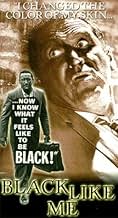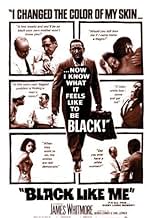Based on the true story of a white reporter who, at the height of the civil-rights movement, temporarily darkened his skin to experience the realities of a Black man's life in the segregated... Read allBased on the true story of a white reporter who, at the height of the civil-rights movement, temporarily darkened his skin to experience the realities of a Black man's life in the segregated South.Based on the true story of a white reporter who, at the height of the civil-rights movement, temporarily darkened his skin to experience the realities of a Black man's life in the segregated South.
- Awards
- 1 win total
Lenka Peterson
- Lucy Horton
- (as Lenka Petersen)
P. Jay Sidney
- Frank Newcomb
- (as P.J. Sidney)
Featured reviews
This is a good movie but the book is better. In the book the emotions unfold over a longer period of time which is more realistic. The premise of both (without spoilers): white journalist darkens skin in order to appear black and details his experiences as a black man in the south in a book. Therein lies the problem. Griffin's life as a white man is not erased by the darkening of his skin. For example, in both the book and the movie, Griffin looks for normalcy in activities that blacks during that time period were aware would result in hostility. Going into white neighborhoods attempting to get change in stores. Offensive conversations in cars with whites while hitch hiking, etc. To be clear, blacks were definitely angered by any indignities caused by these experiences. However many of the blacks during that time period never had the privileges that Griffin had had all of his life. My point is that Griffin's anger reaches a crescendo at a quick pace because of a life of white privilege suddenly hindered by dark skin. Blacks cared about daily indignities but always with a concern over the larger political and social institutions and structures that created them. The book and the movie are accurate in many ways, but they represent merely a snapshot of a much larger scheme.
For you people who don't know. This movie is based on a book by John Howard Griffin. In real life he dressed like a black man in 1959 and went about in Mississippi for five or six weeks. During this time he also went as himself a white-man, in order to compare certain scenarios. He was treated differently as a black man because that is how the white people decided to treat him. Not because he told them to, not because he did anything wrong. That's just how he was treated. The movie just happens to show what his experiences were. For all the people who believe racism doesn't exist just because they aren't racist (or at least said anything racist out loud) you aren't living in reality or at least America. True it isn't as blatant now as it was then it is real. So if you don't like this movie fine. But don't let your ignorance of how the world (or at least America)works be your reason for not liking this movie.
James Whitmore gives a good performance as a white man who is given medical treatments to turn the pigmentation of his skin to resemble that of an African American. Based on the fine book by John Howard Griffin he heads off to the south to see what being a black person in the U.S. is like.
The film recently aired on AMC. It is somewhat dated and Whitmore doesn't appear to be any thing other than a Caucasian with dark make up on. The film nonetheless is quite good as it examines his journey through the south. He encounters prejudice at virtually every stop. The film tends to lag at certain points but still delivers a powerful story. Read the book first then see this early 60's picture
The film recently aired on AMC. It is somewhat dated and Whitmore doesn't appear to be any thing other than a Caucasian with dark make up on. The film nonetheless is quite good as it examines his journey through the south. He encounters prejudice at virtually every stop. The film tends to lag at certain points but still delivers a powerful story. Read the book first then see this early 60's picture
This is the sleepy South as it really was. The pace is deliberate but necessarily so. The direction and acting is gritty and real.
The anger was real. The prejudice was real. The hate was real. The fear was real. The pain was real. It really happened this way.
This movie shows us all that. We walk in the shoes of a white man who looks like a black man...but we will never know. We can only imagine like James Whitmore's character, John Horton. We can only imagine what a man or woman had to endure in the unilluminated history of the United States.
Seeing this, we know, though we have come quite some distance, that we have still a long way to go before the reality is but a memory.
I salute all of those involved in this film and Mr. John Howard Griffin who endured it all and let us know the cruelty of man and helped us open our eyes.
The anger was real. The prejudice was real. The hate was real. The fear was real. The pain was real. It really happened this way.
This movie shows us all that. We walk in the shoes of a white man who looks like a black man...but we will never know. We can only imagine like James Whitmore's character, John Horton. We can only imagine what a man or woman had to endure in the unilluminated history of the United States.
Seeing this, we know, though we have come quite some distance, that we have still a long way to go before the reality is but a memory.
I salute all of those involved in this film and Mr. John Howard Griffin who endured it all and let us know the cruelty of man and helped us open our eyes.
Griffin's book, which I highly recommend reading, is not well reflected in this movie. The book is an important one- the movie failed to portray the events deeply and meaningfully. While the book draws one into the experience and emotion of one living as an Arfican-American in the South during this time, the film leaves one feeling little more than a disconnected witness of a poor narration.
Poorly directed, poorly cast, abysmally lit and acted, often to the extent that Griffin's message is lost in the morass. At times the director has taken such creative license as to change Griffin's character, adding nothing, distracting from the premise and in so doing disconnects the viewer from the protagonists world.This movie screams to be remade as the important bridge in cultural understanding that the book remains.
Poorly directed, poorly cast, abysmally lit and acted, often to the extent that Griffin's message is lost in the morass. At times the director has taken such creative license as to change Griffin's character, adding nothing, distracting from the premise and in so doing disconnects the viewer from the protagonists world.This movie screams to be remade as the important bridge in cultural understanding that the book remains.
Did you know
- TriviaGriffin actually went through the pigment darkening process twice. The first time was for his original article in Sepia Magazine. The second time was much later for the book, when he returned to some of the same locales to be photographed in character.
- GoofsWhen Horton, after meeting the PhD student, opens his wallet to pay in the diner, something falls out of it near the counter. No one notices or refers to it.
- ConnectionsFeatured in Classified X (2007)
- How long is Black Like Me?Powered by Alexa
Details
Box office
- Budget
- $273,000 (estimated)
- Runtime1 hour 45 minutes
- Color
- Sound mix
Contribute to this page
Suggest an edit or add missing content

































